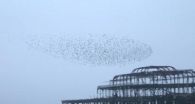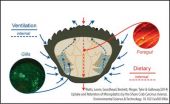(Press-News.org) This news release is available in Portuguese.
This news release is available in Portuguese.
The identification of the genes and proteins involved in a biological process, as well as the way they interact, are essential for the understanding of that process. However, often little is known about the dimensions of molecular biological structures. Knowing how many molecules make up a structure and are required for its function are essential for our understanding of biological mechanisms. Yet, quantifying molecules of infinitesimal size poses a difficult challenge. Now, in a breakthrough study, Lars Jansen and his team from Instituto Gulbenkian de Ciência (IGC, Portugal) were able to measure the amount of protein molecules in living human cells required to form an important structure of the chromosome, the centromere. This study, published this week in the open access scientific journal eLife*, presents new methodologies that may also be used to unveil other biological problems.
Centromeres are protein structures present at chromosomes. These structures recruit the necessary molecular machinery that drives the segregation of chromosomes into the daughter cells, a process essential for cell division. If the location of centromeres is changed or if the proteins that compose these structures are impaired, abnormal cell divisions may arise. Lars Jansen's laboratory, together with other research groups, have identified the components of centromeres and found one protein, called CENP-A to be central to centromere function. What has been lacking thus far is a measure of how many of these molecules are present which is important to understand how centromeres are built and maintained.
Dani Bodor, PhD candidate at Jansen's laboratory and first author of this study, explains the context of this study: "We knew the CENP-A protein was playing a crucial role in the formation of centromeres. Previous studies showed that without this protein, cells failed to divide properly, with consequences in the number of chromosomes transmitted to the daughter cells. But exactly how much CENP-A was required to form a centromere? We needed to find a way to count CENP-A molecules, that have a size in the order of nanometers (1.000.000 times smaller than 1 millimeter)."
The research team set to develop tools that allow for such a measurement. Using modern genetic engineering they fused a gene that codes for a fluorescent protein to the CENP-A gene. By using this genetic trick, all CENP-A proteins produced by cells became fluorescent. Next, the researchers observed these cells under the microscope, and were able to quantify the total amount of fluorescence present in the cell and the fraction of fluorescence at centromeres. Ultimately, these measurements allowed them to determine that approximately 400 molecules of CENP-A are present on the centromeres of human cells.
Dani Bodor says: "We were inspired by a methodology used in yeast. But until now, no one had used it to measure molecules in more 'complex' cells. Yeast cells have more or less the same shape and volume, but human cells differ in shapes and volumes which increases the degree of complexity when this kind of techniques are used."
To confirm their calculations were accurate, the researchers used two other techniques. Their results showed that independently of the technique used they would always reach a number around 400.
Lars Jansen says: "Centromeres need to be very stable structures to ensure the faithful transmission of chromosomes to the daughter cells during cell division. When cells divide, the CENP-A proteins are distributed to the daughter cells, and the number of molecules that each cell receives may vary. By having 400 molecules the cell can assure that a sufficient number of CENP-A is passed to form the centromeres. The calculation of the number of CENP-A molecules allows us to propose a mechanistic framework that can explain the formation and inheritance of centromeres".
When asked about the technical difficulties faced during this study Lars says: "We took 5 years to conduct this work, and for sure we would not be able to have done it 10 years ago. We need to develop new techniques continuously to be able to go further and answer novel questions, even to old biological problems. We have arrived at a time in biology where more and more laboratories will start looking at the quantitative aspects of the biological problem they are studying. The techniques we have employed can be quite helpful for that."
INFORMATION:
Lars Jansen received a Consolidator Grant from the European Research Council (ERC) in the beginning of this year to continue his studies on centromeres and on the mechanisms that control the faithful transmission of non-genetic information from mother to daughter cells.
This study was conducted at the Instituto Gulbenkian de Ciência, in collaboration with researchers from Harvard Medical School (Boston, USA), University of Pennsylvania (Philadelphia, USA), and University of California (La Jolla, USA). This research was made possible by funding from the European Molecular Biology Organization (EMBO), European Commission, European Research Council, National Institute of Health, Burroughs Wellcome Fund, Rita Allen Foundation, Beckman Laser Institute and Foundation, and Fundação para a Ciência e a Tecnologia (Portugal).
* Bodor, DL, Mata, JF, Sergeev, M, David, AF, Salimian, KJ, Panchenko, T, Cleveland, DW, Black, BE, Shah, JV, Jansen, LET (2014). The quantitative architecture of centromeric chromatin. eLife 3: e02137. http://dx.doi.org/10.7554/eLife.02137
Measuring the number of protein molecules inside cells
2014-07-18
ELSE PRESS RELEASES FROM THIS DATE:
Revealed: The mystery behind starling flocks
2014-07-18
The mystery behind the movements of flocking starlings could be explained by the areas of light and dark created as they fly, new research suggests.
The research, conducted by the University of Warwick and published in the journal PNAS, found that flocking starlings aim to maintain an optimum density at which they can gather data on their surroundings. This occurs when they can see light through the flock at many angles, a state known as marginal opacity. The subsequent pattern of light and dark, formed as the birds attempt to achieve the necessary density, is what provides ...
Adults with eosinophilic esophagitis should consider a diet change
2014-07-18
Bethesda, MD (July 18, 2014) — Dietary elimination is a successful method of treatment for adults with eosinophilic esophagitis (EoE), according to a new study1 in Clinical Gastroenterology and Hepatology, the official clinical practice journal of the American Gastroenterological Association.
"By eliminating specific foods from patients' diets, symptoms improved in 71 percent of patients, and endoscopic appearance improved in 54 percent," said lead study author, W. Asher Wolf, MD, MPH, and co-author Evan S. Dellon, MD, MPH, from the division of gastroenterology and hepatology, ...
Genetic variations may modify cardiovascular benefit of aspirin
2014-07-18
BOSTON – Aspirin is the gold standard for antiplatelet therapy and a daily low-dose aspirin is widely prescribed for the prevention of cardiovascular disease.
Now, a new study suggests that common genetic variation in the gene for catechol-O-methyltransferase (COMT) may modify the cardiovascular benefit of aspirin, and in some people, may confer slight harm. The findings, led by investigators at Beth Israel Deaconess Medical Center (BIDMC) and Brigham and Women's Hospital (BWH) appear online in the American Heart Association journal Arteriosclerosis, Thrombosis, and ...
Microplastics worse for crabs and other marine life than previously thought, study shows
2014-07-18
The tiny plastic particles polluting our seas are not only orally ingested by marine creatures, but also enter their systems through their gills, according to a new study led by the University of Exeter.
Scientists also discovered that when microplastics are drawn in through this method they take over six times longer to leave the body compared with standard digestion.
Lead author Dr Andrew Watts of the University of Exeter said: "Many studies on microplastics only consider ingestion as a route of uptake into animals. The results we have just published stress other ...
The bend in the Appalachian mountain chain is finally explained
2014-07-18
The 1500 mile Appalachian mountain chain runs along a nearly straight line from Alabama to Newfoundland—except for a curious bend in Pennsylvania and New York State. Researchers from the College of New Jersey and the University of Rochester now know what caused that bend—a dense, underground block of rigid, volcanic rock forced the chain to shift eastward as it was forming millions of years ago.
According to Cindy Ebinger, a professor of earth and environmental sciences at the University of Rochester, scientists had previously known about the volcanic rock structure under ...
Immune cell's role in intestinal movement may lead to better understanding of IBS
2014-07-18
Learning the role of immune-system cells in healthy digestive tracts and how they interact with neighboring nerve cells may lead to new treatments for irritable bowel syndrome (IBS). Researchers from Penn State College of Medicine, in collaboration with other scientists, have reported the role of macrophages in regulating the contractions of the colon to push digested material through the digestive tract.
The muscular lining of the intestine contains a distinct kind of macrophage, an immune system cell that helps fight infections. The role of these cells in normal colon ...
It's go time for LUX-Zeplin dark matter experiment
2014-07-18
New Haven, Conn. -- From the physics labs at Yale University to the bottom of a played-out gold mine in South Dakota, a new generation of dark matter experiments is ready to commence.
The U.S. Department of Energy's Office of Science and the National Science Foundation recently gave the go-ahead to LUX-Zeplin (LZ), a key experiment in the hunt for dark matter, the invisible substance that may make up much of the universe. Daniel McKinsey, a professor of physics, leads a contingent of Yale scientists working on the project.
"We emerged from a very intense competition," ...
Improving driver safety: How to prevent streetlight glare in the new world of LED lighting
2014-07-18
WASHINGTON, July 18—Long hours of nighttime driving can cause eyestrain because while our vision adapts to the surrounding darkness, the sudden stabs of brightness from streetlamps can be irritating, distracting and even painful. Even as LED technology has transformed the lighting industry, bringing the promise of more energy-efficient road illumination, some fear that the new lights could cause even more troublesome, unsafe glare.
A team of researchers from China and the Netherlands has developed a way to evaluate the human impact of uncomfortable glare caused by LED ...
NASA sees super typhoon Rammasun eyeing landfall
2014-07-18
Imagery from NASA's Aqua satellite captured a wide-eyed Typhoon Rammasun as it was making landfall in northern Hainan Island, China early on July 18. A rainfall analysis using another NASA satellite showed the flooding potential of the storm as it left the Philippines and headed for China. Now, Rammasun is headed for a final landfall near the northeastern border of Vietnam and China.
On July 17, an analysis of Typhoon Rammasun's rainfall was conducted at NASA's Goddard Space Flight Center in Greenbelt, Maryland. The rainfall analysis covered the storm's rainfall from ...
NASA satellite catches birth of Tropical Storm Wali near Hawaii
2014-07-18
The first tropical cyclone of the season has formed in the Central Pacific Ocean as NASA's Terra satellite passed overhead. Tropical Storm Wali formed southeast of the Big Island of Hawaii, and now that it's nearing, a Flash Flood Watch has been posted for all of the islands.
NASA's Terra satellite passed over Wali on July 17 at 19:55 UTC (3:55 p.m. EDT) just as it was being classified as Tropical Depression 1C. NOAA's Central Pacific Hurricane Center (CPHC) issued an advisory at 5 p.m. EDT (11 a.m. HST) announcing the birth of the depression near 12.7 north and 140.7 ...






